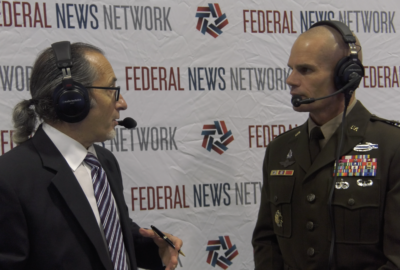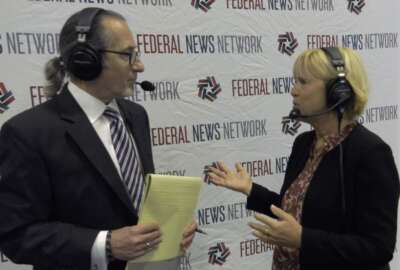Hubbard Radio Washington DC, LLC. All rights reserved. This website is not intended for users located within the European Economic Area.
How the Army plans to deal with ‘tons’ of stuff brought back from Afghanistan
The Army also has completed the establishment of a national chain of what it calls MDRS's - Modernization, displacement and repair sites.
Best listening experience is on Chrome, Firefox or Safari. Subscribe to Federal Drive’s daily audio interviews on Apple Podcasts or PodcastOne.
The Army famously left behind physical assets when the Biden administration ordered the sudden pullout from Afghanistan. But the Army also airlifted tons and tons of vehicles, weapons, ordnance and other gear. The Army also has completed the establishment of a national chain of what it calls MDRS’s – Modernization, displacement and repair sites. For an update at this week’s Association of the U.S. Army conference in Washington, Federal Drive with Tom Temin caught up with the commander of the Army Sustainment Command Maj. Gen. Chris Mohan.
Interview transcript:
Chris Mohan: So as we think about the modernization strategy that the Army is currently executing, we know that we’re going to have units that we have to displace a large amount of equipment as we field all the new systems that are coming online. The MDRS concept started with “Okay, well, what do we have in the units right now? And what do we need to do to help them prepare for the re-arm process, and we’re going to get all this?” So the key piece of MDRS is we’re going to go in and efficiently and expeditiously as possible. We’re going to take all of their excess equipment out of those units.
Tom Temin: And when we say equipment, we mean what? Everything from tanks –
Chris Mohan: Trucks, tanks, weapons, as we fill – like for example, we’re filling cross the Army, the new pistol, and so we’ll go in and in conjunction with the fielding of the new pistol we’ll take all the old pistols out and then send it back to depot or send it to wherever they need to go. To other units, cascade them across. So there’s really three big things that we want to do with MDRS: One is we want to get as much excess out as fast as possible. Two, we want to increase readiness of other units as we cascade equipment across the Army. And then three, we want to take this stuff, the excess equipment that we need to rebuild and get it back to the depots, and arsenals as fast as possible to rebuild it. So then we can put it back into the supply system.
Tom Temin: So these MDRS’s now are up and running at pretty much all the all the installations –
Chris Mohan: Major installations across the Army. And again, we have a dedicated team at each site. We centrally manage it, decentralized execution at the actual installations in close coordination with our partners on the installations, the maneuver units. And through that process, in our centralized execution, we’re able to look at best practices, for example. Okay, how do we make the process smoother? We’ve gotten it down to a unit needs to turn it in a Humvee this excess, three pieces of paper, I mean, as easy as possible for the soldiers, because the burden is on our young soldiers who are in the supply rooms, who have to process all these transactions. So when we approach the problems that we approach it from, what can we do to make that soldier’s life easier?
Tom Temin: And I imagine these centers must look sort of like giant pawn shops of military gear, everything from pistols to trucks.
Chris Mohan: Yeah, absolutely. And then that last piece is clearing it out to get it off the installation as fast as possible. But we do have places where we have large motor pools, as we’re waiting, working with our partners, Defense Logistics Agency for example, to process and ship out. And that’s the third leg of the stool, where we’ve got to work to efficiently get that stuff out of the installation as fast as possible.
Tom Temin: And you mentioned three pieces of paper – let me ask you this: Does this tie into the logistics systems that track all of this gear in the first place? You don’t have to reinvent that.
Chris Mohan: Absolutely. So the first one is the piece of paper that directs the action. So we have a dedicated team that looks across all the Army and the Army’s equipment we manage. Army Sustainment Command is the lead material integrator, execution arm for Army Materiel Command. And so we look and say, okay, your unit, you’ve got two excess Humvees, this unit has holes for two Humvees. So let’s put them into the MDRS. We will as fast as possible, ship them to fill those shortages in this other unit. And that comes down to a document that we produce. It says, “Hey, here’s the hole, here’s the excess – execute.”
Tom Temin: Got it. And let me ask you about Afghanistan. Famously, a lot of stuff was left there. But a lot of stuff –
Chris Mohan: A lot of stuff came out.
Tom Temin: Came back, yeah so tell us about how that’s being handled.
Chris Mohan: So as we brought all that equipment out, it landed in a couple different spots and literally landed, because vast majority of it, particularly at the end was via airlift. And then we go into a giant yard like an MDRS yard. And we sort it, we determine where it’s going to go – again, the same process. Okay, so do we need this to fill holes in? When I say holes, I’m talking about shortages of equipment and Army pre-position stocks. So we’ll fill holes there. Do units back in CONUS need this? Yes, we’ll fill it. Or do we need to dispose of it through Defense Logistics Agency or other partners? Or in some cases, you know, cascading that equipment over to our allies over in the Middle East. And so that process is ongoing as we sort through the mass amounts of equipment we had after 20 years of war in Afghanistan.
Tom Temin: Yeah. And what is the biggest item in terms of quantity that that is coming back and being processed, do we know that?
Chris Mohan: A lot of Humvees and MWraps that we had in the battlefield. So Humvees, as we fill the [Joint Light Tactical Vehicle] across the Army, both overseas and APS and then back here in CONUS, we’re doing a lot of displacements of Humvees. And then a lot of repair of Humvees – unit turns it in, we do the repair action on it to ship it to the other unit.
Tom Temin: Yeah what is the lifecycle of some of these things, is there a point where when you have a hole and you have a machine, and you might look at it and say, “You know what, this is really ready for scrap.” What’s the process that determines that?
Chris Mohan: So, a technical inspection happens, and says that we believe this unit has this piece of equipment that should be in full emission capable 1020 standards, and which is the technical manual that determines serviceability of equipment. And then we do a validation of it and says yes, its’ 1020. And then we’ll pass it on. If we have a list of equipment that is past a service life extension, and a lot of times those are just as-is turn ins. And that’s the piece. So right now, across the Army, about 77% of the stuff that we need to get out of units is as-is turn ends, because it’s being displaced by new monitoring equipment. And so we just need it. It’s excess equipment, give it to us, and we’ll get rid of it.
Tom Temin: Yeah, give us a sense of what equipment what’s the top of the list for replacement and modernization.
Chris Mohan: So JLTVs, new weapons systems, we’ve done in M1 tanks – we’re taking into their old tanks and put them back to the depot and giving them new tanks. We’ve got some Bradley fighting vehicles that we’ve done in particularly at Ft. Stewart, and we see MDRS’s again being that model. So Ft. Stewart was a test case where we fielded new equipment to a brigade and third infantry division. And we did it in mass, worked out great. But we took that now we need to scale it, and use the capability we have with MDRS, linked and in concert with the acquisition community who was fielding new equipment, and then we take that and do almost like a refresh of the unit, take their old stuff, give them new stuff in a very synchronized manner as synchronized as possible.
Tom Temin: So if I’m a post office or a VFW hall or local town hall, how do I get one of those retired things to paint and put out front for perpetuity?
Chris Mohan: There is, as the Army, right, so there is a process for everything. Tank-automotive and Armaments Command (TACOM) has an office that they do that, they actually do that.
Tom Temin: Alright, so well I may put one on my front lawn, give the neighbors a little bit of a thrill. And let me just ask you, does this tie in in any way with retrograde operations? Because wouldn’t that result in things that have to be sent to the MDRS’s?
Chris Mohan: Yeah, it’s one in the same, executed in different spots. So the Afghan retrograde that we were currently still working through in Kuwait is not exactly called MDRS but it’s the same concept. Take it, reutilize it, get it to units to increase their readiness, or turn into the depots or to deal IDS.
Tom Temin: Yeah, that’s a good point. This happens worldwide. The Army is pretty much in every time zone at some point.
Chris Mohan: Absolutely. And so is Army Sustainment Command.
Tom Temin: Indeed.
Copyright © 2024 Federal News Network. All rights reserved. This website is not intended for users located within the European Economic Area.
Tom Temin
Tom Temin is host of the Federal Drive and has been providing insight on federal technology and management issues for more than 30 years.
Follow @tteminWFED
Related Stories
On DoD

WEDNESDAYS, 11 A.M. & 2 P.M.
Each week, Defense Reporter Jared Serbu speaks with the managers of the federal government's largest department. Subscribe on PodcastOne or Apple Podcasts.





